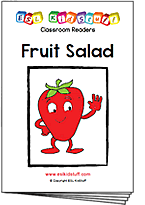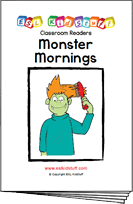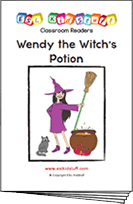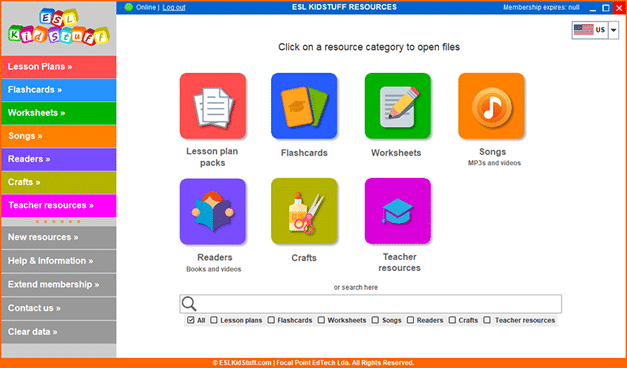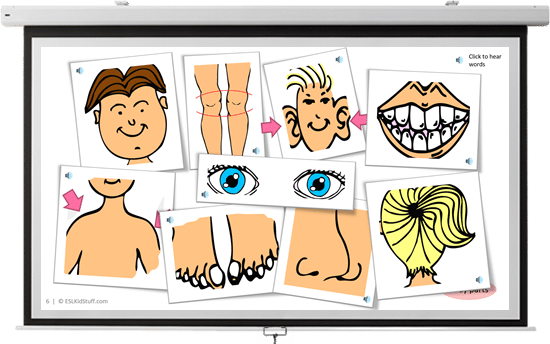Fruit and counting 1 lesson plan
“3 bananas”
Lesson 4 Level 2 Age 5-7
Lesson plans for ESL kids teachers
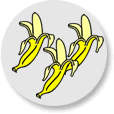
Lesson 4
Fruit and counting 1
This lesson continues with the theme of fruit and introduces numbers. Students learn to say the fruit they like and count to 6. They play fun games and activities, sing songs and read a fun story about fruit.
Members get accompanying flashcards, worksheets, songs and reader.
Materials:
Our lesson plans are FREE!
Sign up for accompanying:
✔ worksheets
✔ homework sheets
✔ craft sheets
✔ flashcards
✔ PowerPoint lessons & multimedia
✔ song downloads & videos
✔ classroom readers & videos
Click to see lesson details, materials and supplies
Age: 5-7 years
Time: 50 mins – 1 hour 10 mins
Objectives: Identify and recognize 8 fruit, saying fruit you like, count to 6.
Structures: “What fruit is it?”, “How many are there?”, “What fruit do you like (to eat)?”, “I like …”, “I like them very much.”
New vocabulary: 1, 2, 3, 4, 5, 6.
Review vocabulary: apple, banana, grapes, orange, melon, pineapple, lemon, strawberry.
Lesson materials
Flashcards:
- apple, banana, grapes, orange, melon, pineapple, lemon, strawberry
Printables:
- Fruit salad reader worksheet
- 1-6 fruit worksheet
- Count and [hide_on_uk]color[/hide_on_uk][hide_on_us]colour[/hide_on_us] 1-6 worksheet
Songs:
- Hello song
- Goodbye song
- What fruit do you like?
Readers:
- Fruit salad
Supplies:
- [hide_on_uk]colored[/hide_on_uk][hide_on_us]coloured[/hide_on_us] pencils
- name tags for each student
- a glove puppet
- name tracing sheets (one for each student with their name in dots) – optional
- plastic fruit (in a small box)
- a length of rope
- a box with objects in to count
- cushions (1 per student)
- device to play the songs on
Students start learning to count! They learn to count to six and practice counting fruit as well as other objects. They also read a fun story and sing a song about fruit.
Lesson procedure:
Warm up and maintenance:
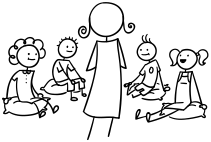
1. Greetings
Greet the students by name as they enter the classroom and gesture for them to sit down (on cushions if you have them) in a fan-shape around you.

2. Name tags
Before class, prepare some name tags (stickers or pin-on tags).
If your students can not write their names well:
have each student’s name written in dots or dashes in lower-case letters on the tags. Sit down with your students and lay out the name tags in front of you. Pick up each tag and encourage the student to recognize his/her name. Do this for everyone.
Finally, have everyone take out a pencil and trace their name on their tags and stick them on.
If your students can write their names well:
simply give a blank name tag to each student to write their name on in pencil and stick it on.

3. Glove puppet greetings
Bring out your glove puppet bag and have everyone shout “Hello!“ into the bag until he wakes up and jumps out of the bag. Then model chatting with the glove puppet …
Puppet: “Hello”, What’s your name?”
Teacher: “My name is…”.
Puppet: “How are you?”
Teacher: “I’m fine, thank you”.
… and then have the puppet say hello to each student and ask them the same questions.
Finally, go around saying “Goodbye” and “See you” before going back into the bag and back to sleep.
4. Sing the “Hello song”
Sit in a circle and sing the song (clap along or pat knees).
Lyrics for the “Hello song”
Hello, hello,
How are you today?
Hello, hello,
How are you today?
I’m fine, thank you,
I’m fine, thank you,
I’m fine, thank you,
And how about you?
Hello, hello,
How are you today?
I’m fine, thank you,
And how about you?
Gestures for the “Hello song”
These are quite straight forward. First time you play the song do the gestures and encourage everyone to do them with you.
- Wave as you sing the “Hello, hello” parts.
- Gesture to others as you sing, “How are you today?”
- Point to yourself as you sing, “I’m fine, thank you”
- Hand gesture towards another student as you sing, “And how about you?”.

[hide_on_uk]Short sample (members get full-length song):
[/hide_on_uk]
[hide_on_us]Short sample (members get full-length song):
[/hide_on_us]
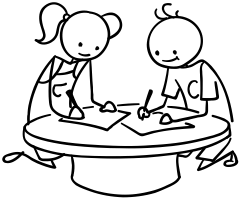
5. Name writing practice
This is an optional activity you can do if your students can’t write their names in English. If they can, skip this step.

Everyone sits at a table with you. Take the name writing practice sheets from last lesson (with your students’ names written in dots or dashes) and read the names out – encourage each student to put their hand up and say, “Yes”. Give out the sheets to each student.
Next, say, “Take out your pencils” and have everyone trace their name using different [hide_on_uk]colors[/hide_on_uk][hide_on_us]colours[/hide_on_us]. As the students trace their names, circulate, help and give lots of praise. Be sure to elicit red, blue, green, yellow and purple [hide_on_uk]colors[/hide_on_uk][hide_on_us]colours[/hide_on_us] as a review from last class.
Finally, praise and reward students for doing a good job!

6. Homework check
Check each student’s homework that you set in the last lesson. Ask each student some questions about their homework worksheet (e.g. “What fruit is this?, “What [hide_on_uk]color[/hide_on_uk][hide_on_us]colour[/hide_on_us] is it?”), give lots of praise, and then put some kind of mark on the homework sheet (e.g. a sticker, a stamp or draw a smiley face).
Finally, tell your students to put their homework back into their bags.
7. Do “Exercise routine” activity
Say the following and have the students follow your lead:
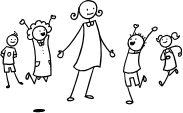
- “Stand up” (Teacher stands and so does everyone else)
- “Hands up / hands down” (do 4 or 5 times)
- “Jump” (4 or 5 times)
- “Kick” (4 or 5 times)
- “Run! / Stop!” (4 or 5 times)
- “Turn around! / Stop!” (4 or 5 times)
- “Wiggle!” (a few seconds)
- finally “Sit down”.

8. Review fruit: apple, banana, grapes, orange, melon, pineapple, lemon, strawberry
Use the plastic fruit from the previous lesson. Sit everyone in a circle around you. Take out the box with the fruit in and shake it – the rattling sound will instantly alert your students.
Open the box and pull out a fruit. Ask “What’s this?” Elicit the word and chorus x3. Next, mime biting the fruit and chewing, and then say “Yummy!”. Then hold the fruit in front of each student to let them take an imaginary bite. Encourage them to say “yummy!” or even “yuk!”. Repeat with the other fruit.
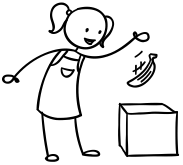
9. Play “Fruit fetch”
You’ll need enough plastic fruit pieces for each student (e.g. if you have 16 students, you’ll need two of each plastic fruit – if you don’t have enough plastic fruit use our fruit flashcards instead).
Have your students sit on the floor. Throw the fruit around the classroom. Model the activity: say “(Your name) give me a/an (apple)”. Get up, find the fruit and put it into the box. Now hold the box and instruct a student to pick up a fruit, bring it back to you and put it in the box. Do for each student in the class so that all of the fruit has been collected. Repeat for fun.
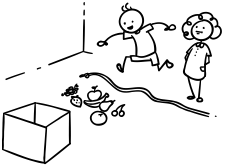
10. Play “Fruit rope jump” game
Take a length of rope and lay it across the floor at one end of the classroom. On one side place the 8 plastic fruit and the box. Have your students line up on the other side of the rope. Model: “(Your name), put the (apple) in the box”. Run up to the rope, jump over the rope (say “Jump!”) select the correct fruit and put it in the box.
Now instruct each student to do the activity.

11. Do review quiz: Fruit memory game
This is a fun memory game. Print off the fruit flashcards before class. Have your students sit in a circle on the floor and sit with them. Lay the flashcards on the floor, face-up, and elicit each fruit as you lay them out. Then, tell everyone that they have to remember each flashcard. Give them 10 seconds to memorize.
Next, turn each of the flashcards over, so you can only see the backs. Point to one card and ask, “What fruit is this?” and encourage everyone to shout out the answer. Then, turn over the card to reveal the fruit. If everyone is correct, leave the card as it is. If wrong or didn’t know, turn the card back over. Then continue for the rest of the cards.
New learning and practice:
1. Read classroom reader “Fruit salad“
Before class, download and print off the reader “Fruit salad” from our website. As you go through each page, point to the pictures and let your students shout out what fruit they see, for example:
Teacher: What fruit is this? (pointing at the green apple on page 3)
Students: It’s an apple!
Teacher: Yes, that’s right! And what [hide_on_uk]color[/hide_on_uk][hide_on_us]colour[/hide_on_us] is it?
Students: Green!
Teacher: Right! Good job! (reading from the story) … “Along came an apple …”.
Get the students really involved in the story by asking lots of questions (e.g. eliciting the fruit and their [hide_on_uk]colors[/hide_on_uk][hide_on_us]colours[/hide_on_us]) and try to get everyone shouting out the frame, “They pushed and they heaved. But it was too heavy!”.

After reading the story, give out a reader worksheet to each student and read through the story one more time (without stopping for questions, etc.) as students draw lines to the fruit in the order of the story. Then go through the answers as a class.
Alternatively, watch our video version of the reader (Internet connection required).
2. Sing the “What fruit do you like?” song
For the first time you play the song, have everyone sit down and watch you. Stand in the middle of the room and sing / clap along to the song. Once the song reaches the fruit vocab, point at the A4 pictures on the wall for each fruit as it is sung. Next, get everyone to stand up and sing along, pointing the pictures. You can also stick our song poster on the board to help.
Lyrics for “What fruit do you like?”
Verse 1:
What fruit do you like? What fruit do you like?
I like apples, bananas, oranges, grapes,
I like them very much.
I like apples, bananas, oranges, grapes,
I like them very much.
Verse 2:
What fruit do you like to eat? What fruit do you like to eat?
I like melons, pineapples, lemons, strawberries,
I like them very much.
I like melons, pineapples, lemons, strawberries,
I like them very much.
Gestures for “What fruit do you like?”
There are no specific gestures for this song. You can have the kids clap along and pat their knees as they sing. Also, have them point to the fruit pictures on the classroom walls as they sing each fruit (see point 6 above).

[hide_on_uk]Short sample (members get full-length song):
[/hide_on_uk]
[hide_on_us]Short sample (members get full-length song):
[/hide_on_us]
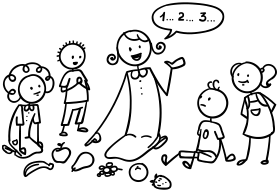
3. Teach counting 1-6
Sit your students down so they are facing you. Use some plastic fruit or fruit flashcards to teach counting.
First, take 6 pieces of fruit and put each one on the floor / table in front of you in a line. Then touch each fruit and slowly count (T: “1 … 2 … 3 … 4 … 5 … 6”). Do this two or three times. Then have the class all repeat as you count / touch each fruit.
Then, everyone sits in a circle and claps slowly, counting to on each clap 1-6. As everyone chants the numbers, speed up the clapping each round.
Finally, ask one or two students to touch and count the fruit as the rest of the class watches (give lots of encouragement and congratulate them when finished).
4. Practice counting 1-6
Put the students in pairs and give each pair a number of objects (e.g. 6 plastic fruit, 6 cars, 6 pencils, etc.). Have the students practice counting and touching the objects.
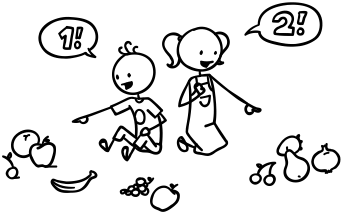

5. Play “Put in the box”
Get a big box of objects and make sure you have 6 objects for each category (e.g. 6 plastic fruit, 6 cars, 6pencils, 6 blocks, 6 teddies, etc.). Throw the objects all around the classroom. Then choose a student and say, “Put six (pencils) in the box”.
As the student picks up each object make sure everyone counts along (1… 2 … 3 … 4 … 5 … 6). Then have the student count the objects as s/he puts them in the box. Do this with everyone.
Finally, for a bit of crazy fun, throw all the objects out and let everyone scramble to find, count and put all of their objects back in the box again (all at the same time!).
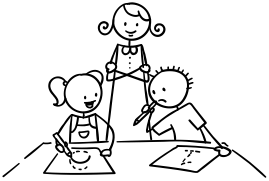
6. Do “1-6 fruit” worksheet
Hold up worksheet and model counting the apple and [hide_on_uk]coloring[/hide_on_uk][hide_on_us]colouring[/hide_on_us] it in. Then move onto the pineapple. Count the circles “1 .. 2”, [hide_on_uk]color[/hide_on_uk][hide_on_us]colour[/hide_on_us] the pineapple and then draw and [hide_on_uk]color[/hide_on_uk][hide_on_us]colour[/hide_on_us] a pineapple in the second circle.
Continue for all of the numbers and fruit, all the time eliciting the fruit and [hide_on_uk]colors[/hide_on_uk][hide_on_us]colours[/hide_on_us] and counting. Have your students take out their crayons and complete their worksheets. Spend time with each student, helping, asking questions and praising. Finally, hold up each student’s work in turn and them ask to count the fruit pictures.
Tell your students to put their worksheets into their bags.
Wrap up:

1. Assign homework: “Count and [hide_on_uk]color[/hide_on_uk][hide_on_us]colour[/hide_on_us] 1-6”
Hold up the homework worksheet and model counting and [hide_on_uk]coloring[/hide_on_uk][hide_on_us]colouring[/hide_on_us] in the objects. Give out the worksheets and say, “Put your homework in your bags” and help them to do so – this is important as they will probably want to start [hide_on_uk]coloring[/hide_on_uk][hide_on_us]colouring[/hide_on_us] them right away.

2. Say goodbye to the glove puppet
Take out the bag again and get everyone to wake up the glove puppet by shouting its name into the bag (e.g. “Cookie Monster!”). Bring out the puppet and go through the same routine – go to each student and say hello, ask their name and the say goodbye / see you. Then put the puppet back in the bag (back to sleep).
3. Sing the “Goodbye song”
Sit together in a circle and sing and clap along.
Lyrics for the “Goodbye song”

Goodbye, goodbye,
See you again.
Goodbye, goodbye,
See you again.
It’s time to go,
It’s time to go,
It’s time to go,
See you next time.
Goodbye, goodbye,
See you again.
It’s time to go,
See you next time.
Gestures for the “Goodbye song”
These are quite straight forward. First time you play the song do the gestures and encourage everyone to do them with you.
- Wave as you sing the “Goodbye, goodbye” parts.
- Hold your hand above your eyes (as you would when you are looking into the distance and keeping the sun out of your eyes) and look at another student as you sing, “See you again”.
- Tap watch (or imaginary watch) and then point to the door as you sing, “It’s time to go”.
- Point towards another student as you sing, “See you next time”.
[hide_on_uk]Short sample (members get full-length song):
[/hide_on_uk]
[hide_on_us]Short sample (members get full-length song):
[/hide_on_us]

4. Do “Quick check” and say goodbye
Time to leave the class. Make sure everything is put away and the students have gathered their belongings. Have them line up at the door and place yourself between the door and the students.
For each student hold up the worksheet from today’s lesson and ask them to count 6 of the fruit.
When they give you the correct answer say goodbye and let them leave. If their answer is wrong, have them go back to the end of the line – they will have to try again once they reach the front!
Other lesson plans
Levels:
Level 1 lessons (Age 3-5)
Level 2 lessons (Age 5-7)
Level 3 lessons (Age 7-9)
Level 4 lessons (Age 9-12)
Mini lessons (all ages)
Lessons in this level:
- Intro lesson
- [hide_on_uk]Colors[/hide_on_uk][hide_on_us]Colours[/hide_on_us] & fruit 1
- [hide_on_uk]Colors[/hide_on_uk][hide_on_us]Colours[/hide_on_us] & fruit 2
- Fruit and counting 1
- Fruit and counting 2
- Review lesson: [hide_on_uk]colors[/hide_on_uk][hide_on_us]colours[/hide_on_us], fruit and counting
- Body and shapes 1
- Body and shapes 2
- Body and shapes 3
- Farm animals
- Zoo animals
- Review lesson: body, shapes and animals
- Classroom objects and toys 1
- Classroom objects and toys 2
- Our world 1
- Our world 2
- Weather
- Review lesson: classroom, toys, our world, weather
- Clothes 1
- Clothes 2
- Vegetables and likes 1
- Vegetables and likes 2
- Feelings and emotions 1
- Feelings and emotions 2
- Review lesson: clothes, vegetables & likes, feelings
- Directions
- Wheels on the bus
- Can for ability 1
- Can for ability 2
- Stationery and possessions 1
- Stationery and possessions 2
- Stationery and possessions 3
- Pets and possessions 1
- Pets and possessions 2
- Review lesson: directions, ability, stationery, pets, possessions
Special lessons:
- Christmas lesson
- Halloween lesson
- Easter lesson
- Thanksgiving lesson


